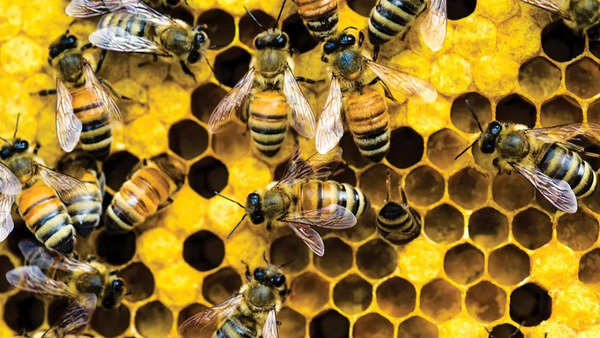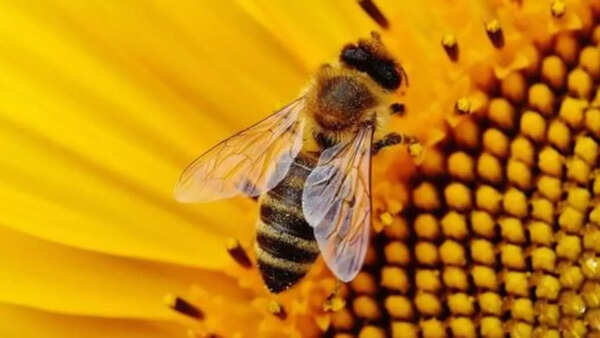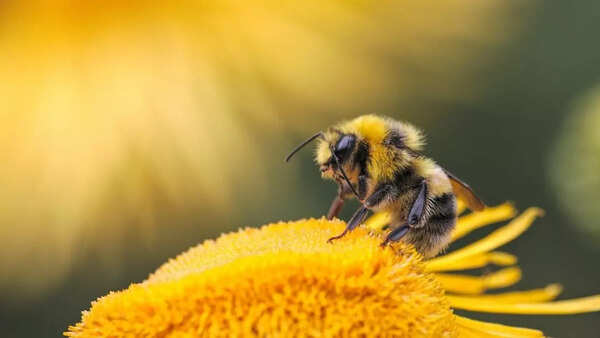US having honey bee crisis: This is what it means for humans, and it is disturbing
Turns out, Meghan Markle’s passion for beekeeping isn’t much helpful after all, as scientists warn of severe honeybee losses in 2025.
Researchers at Washington State University projected that honeybee colonies in the U.S. could decline by up to 70% this year.
Priya Chakrabarti Basu, an assistant professor of pollinator health and apiculture at WSU, said in the news release, "Losses have been increasing steadily. Pollination demands haven’t gone down, so beekeepers face tremendous pressure to keep the same number of colonies to meet those needs."

As per Basu, "I honestly think this is a combination of multiple stressors, which is why for years my lab has been focusing on understanding the impacts of and interactions of these stressors on bee pollinators." She added that America's commercial beekeepers are under pressure to maintain colonies, saying, "The pollination demands haven’t gone down, so beekeepers face tremendous pressure to keep the same number of colonies to meet those needs.”
Several factors are contributing to this alarming trend, such as:
Nutrition Deficiencies: Limited access to diverse and abundant forage reduces bees’ nutritional intake, weakening their health and resilience.
Parasite Infestations: The pervasive presence of varroa mites continues to devastate colonies by transmitting harmful pathogens.
Diseases: Viral infections and other diseases are spreading more rapidly, further compromising bee health.

The implications of potentially losing 70% of honey bee colonies could be huge.
According to the National Institute of Food and Agriculture, about 35% of the world’s food depends on pollinators. Brandon Hopkins, a professor of pollinator ecology at WSU, said in a statement accompanying the release that higher losses could also lead to higher costs for farmers who depend on bee colonies.
As per Hopkins, "I don’t want to be a fear-monger, but this level of national loss could mean increased bankruptcies amongst beekeepers. Growers of crops downstream from almonds may need to scramble if the beekeeper they’ve relied on to pollinate their apple trees, for example, isn’t in business anymore."
As per the USDA, crops that depend on honey bees and other pollinators to grow include fruits and vegetables -- like apples, strawberries, cucumbers, and avocados -- but also nuts, such as almonds and macadamia nuts. Other affected plants include coffee, cocoa, and vanilla, according to the USDA.
The Agriculture Department notes that honeybees had a production value of nearly $350 million in 2023.
Hopkins added that the extreme honeybee colonies also put the almond industry at particular risk this year, saying, "The almond industry frequently asks for strong colonies. But this year, growers are desperate. Anything with live bees in a box is in demand because the industry is short on supply." He added, "I haven’t heard of that since the early days of colony collapse around 2008.”

A declining honey bee population poses a significant threat to human food security and livelihoods, potentially leading to reduced crop yields, increased food costs, and a diminished variety of nutritious foods.
Here's how:
Impact on Food Production: Bees are essential pollinators, playing a crucial role in the reproduction of many crops, including fruits, vegetables, nuts, and seeds. A decline in bee populations can lead to decreased pollination, resulting in lower crop yields and potentially impacting the availability and affordability of these foods. Some examples of foods that rely on bees for pollination include almonds, coffee, apples, avocados, onions, and berries.
Economic Consequences: Beekeeping and the pollination services provided by bees contribute to the livelihoods of many people, especially in rural areas. A decline in bee populations can lead to economic losses for farmers and beekeepers, as well as increased costs for consumers. The pollination of fruits and vegetables by wild bees has a high economic value, and a decline in bee populations could lead to significant financial losses.
Nutritional Deficiencies: Reduced availability of fruits, vegetables, nuts, and seeds could lead to nutritional deficiencies in the human diet, as these foods are essential sources of vital nutrients.
Threats to Biodiversity: Declining bee populations can also have broader implications for biodiversity, as bees are important pollinators for a wide range of plant species, both cultivated and wild. The loss of pollinators can disrupt ecosystems and lead to the decline of other plant and animal species.

In order to combat such severe colony losses, WSU scientists are working on methods for widespread varroa mite control, awareness on commercial honey bee colony management practices, and new research on bee nutrition in the hopes that beekeepers will have better access to healthy food for their colonies, according to the release.
Researchers at Washington State University projected that honeybee colonies in the U.S. could decline by up to 70% this year.
The university said in a news release that in the past decade, honeybee colony losses have averaged 40% to 50% annually. But as per the release, this year, a combination of nutrition deficiencies, mite infestations, viral diseases, and possible pesticide exposure during the previous pollinating season led to higher losses.
Priya Chakrabarti Basu, an assistant professor of pollinator health and apiculture at WSU, said in the news release, "Losses have been increasing steadily. Pollination demands haven’t gone down, so beekeepers face tremendous pressure to keep the same number of colonies to meet those needs."

As per Basu, "I honestly think this is a combination of multiple stressors, which is why for years my lab has been focusing on understanding the impacts of and interactions of these stressors on bee pollinators." She added that America's commercial beekeepers are under pressure to maintain colonies, saying, "The pollination demands haven’t gone down, so beekeepers face tremendous pressure to keep the same number of colonies to meet those needs.”
Several factors are contributing to this alarming trend, such as:
Nutrition Deficiencies: Limited access to diverse and abundant forage reduces bees’ nutritional intake, weakening their health and resilience.
Parasite Infestations: The pervasive presence of varroa mites continues to devastate colonies by transmitting harmful pathogens.
Diseases: Viral infections and other diseases are spreading more rapidly, further compromising bee health.

The implications of potentially losing 70% of honey bee colonies could be huge.
According to the National Institute of Food and Agriculture, about 35% of the world’s food depends on pollinators. Brandon Hopkins, a professor of pollinator ecology at WSU, said in a statement accompanying the release that higher losses could also lead to higher costs for farmers who depend on bee colonies.
As per Hopkins, "I don’t want to be a fear-monger, but this level of national loss could mean increased bankruptcies amongst beekeepers. Growers of crops downstream from almonds may need to scramble if the beekeeper they’ve relied on to pollinate their apple trees, for example, isn’t in business anymore."
As per the USDA, crops that depend on honey bees and other pollinators to grow include fruits and vegetables -- like apples, strawberries, cucumbers, and avocados -- but also nuts, such as almonds and macadamia nuts. Other affected plants include coffee, cocoa, and vanilla, according to the USDA.
The Agriculture Department notes that honeybees had a production value of nearly $350 million in 2023.
Hopkins added that the extreme honeybee colonies also put the almond industry at particular risk this year, saying, "The almond industry frequently asks for strong colonies. But this year, growers are desperate. Anything with live bees in a box is in demand because the industry is short on supply." He added, "I haven’t heard of that since the early days of colony collapse around 2008.”

A declining honey bee population poses a significant threat to human food security and livelihoods, potentially leading to reduced crop yields, increased food costs, and a diminished variety of nutritious foods.
Here's how:
Impact on Food Production: Bees are essential pollinators, playing a crucial role in the reproduction of many crops, including fruits, vegetables, nuts, and seeds. A decline in bee populations can lead to decreased pollination, resulting in lower crop yields and potentially impacting the availability and affordability of these foods. Some examples of foods that rely on bees for pollination include almonds, coffee, apples, avocados, onions, and berries.
Economic Consequences: Beekeeping and the pollination services provided by bees contribute to the livelihoods of many people, especially in rural areas. A decline in bee populations can lead to economic losses for farmers and beekeepers, as well as increased costs for consumers. The pollination of fruits and vegetables by wild bees has a high economic value, and a decline in bee populations could lead to significant financial losses.
Nutritional Deficiencies: Reduced availability of fruits, vegetables, nuts, and seeds could lead to nutritional deficiencies in the human diet, as these foods are essential sources of vital nutrients.
Threats to Biodiversity: Declining bee populations can also have broader implications for biodiversity, as bees are important pollinators for a wide range of plant species, both cultivated and wild. The loss of pollinators can disrupt ecosystems and lead to the decline of other plant and animal species.

In order to combat such severe colony losses, WSU scientists are working on methods for widespread varroa mite control, awareness on commercial honey bee colony management practices, and new research on bee nutrition in the hopes that beekeepers will have better access to healthy food for their colonies, according to the release.
댓글
댓글 쓰기